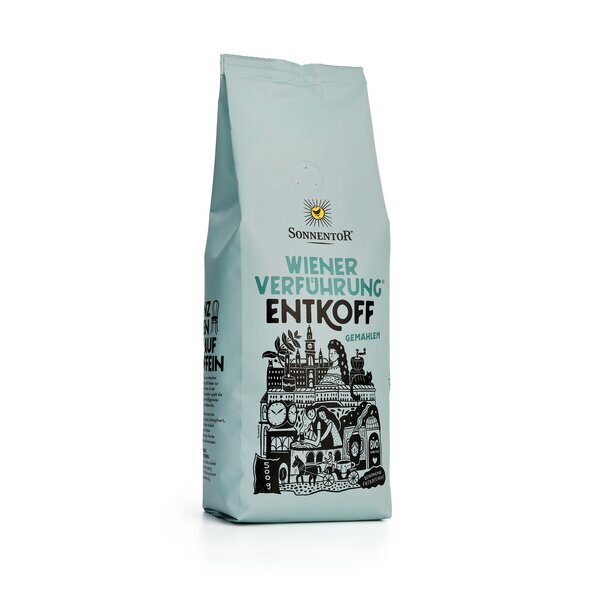Decaffeination happens before roasting, when the coffee beans are still green. Three steps are needed to remove caffeine from the coffee bean without loss of aroma:
1) Steaming
First, the raw coffee is steamed or pre-treated with water to make the surface of the bean and the cell structure permeable for the crystalline caffeine, which is attached to the cell walls of the bean.
2) Decaffeination with a solvent
The beans are then flushed with a solvent. We use liquid carbon dioxide as a solvent for our coffee. It absorbs the caffeine from the bean. When the solvent is saturated with caffeine, it is separated from the coffee and, in a further step, freed from the absorbed caffeine. This cycle is repeated until most caffeine is removed from the coffee bean.
Carbon dioxide is harmless to health and has been subjected to intensive scientific tests. Application, degree of purity, and any residues are strictly regulated by European guidelines.
3) Drying
Finally, the wet, decaffeinated coffee is dried until it reaches the standard moisture content of green coffee and then roasted as usual. The maximum limits for the residual caffeine content are regulated by European guidelines and national regulations. In Germany, the upper limit is 0.1%. Decaffeinated coffee, therefore, has no more than 1 gram of caffeine per 1 kilogram of dried coffee. For comparison: non-decaffeinated coffee has a caffeine content of around 1.5%.
Acidity provides the specific taste of the coffee, without acid it would taste stale and bitter. Caffeic acid stimulates the stomach acid, which can irritate the stomach if consumed in large quantities.
Some acids, especially the coffee-typical chlorogenic acids (total content 4-5%), but also citric and malic acid, can be found even in unroasted beans. These acids are, however, not really noticeable in terms of taste.
SONNENTOR Coffee is made from Arabica beans that are very gently and slowly roasted. In total, about half of the green coffee's acids, especially the chlorogenic acids, are broken down and lost through roasting. Due to the degradation of carbohydrates, however, some flavor-intensive acids are added during the roasting process, especially acetic acid, but also additional citric acid and malic acid. The acidity in coffee varies between pH 4.5 to 5.0.
The Arabica variety has a much longer maturation time than other varieties and therefore has time to develop its components more slowly. Not only do these components contain less caffeine, but they also contain milder acids. Therefore, SONNENTOR coffees taste pleasanter and are gentler on the stomach.
Decaffeinated Coffee ground
Decaffeination happens before roasting, when the coffee beans are still green. Three steps are needed to remove caffeine from the coffee bean without loss of aroma:
1) Steaming
First, the raw coffee is steamed or pre-treated with water to make the surface of the bean and the cell structure permeable for the crystalline caffeine, which is attached to the cell walls of the bean.
2) Decaffeination with a solvent
The beans are then flushed with a solvent. We use liquid carbon dioxide as a solvent for our coffee. It absorbs the caffeine from the bean. When the solvent is saturated with caffeine, it is separated from the coffee and, in a further step, freed from the absorbed caffeine. This cycle is repeated until most caffeine is removed from the coffee bean.
Carbon dioxide is harmless to health and has been subjected to intensive scientific tests. Application, degree of purity, and any residues are strictly regulated by European guidelines.
3) Drying
Finally, the wet, decaffeinated coffee is dried until it reaches the standard moisture content of green coffee and then roasted as usual. The maximum limits for the residual caffeine content are regulated by European guidelines and national regulations. In Germany, the upper limit is 0.1%. Decaffeinated coffee, therefore, has no more than 1 gram of caffeine per 1 kilogram of dried coffee. For comparison: non-decaffeinated coffee has a caffeine content of around 1.5%.
Acidity provides the specific taste of the coffee, without acid it would taste stale and bitter. Caffeic acid stimulates the stomach acid, which can irritate the stomach if consumed in large quantities.
Some acids, especially the coffee-typical chlorogenic acids (total content 4-5%), but also citric and malic acid, can be found even in unroasted beans. These acids are, however, not really noticeable in terms of taste.
SONNENTOR Coffee is made from Arabica beans that are very gently and slowly roasted. In total, about half of the green coffee's acids, especially the chlorogenic acids, are broken down and lost through roasting. Due to the degradation of carbohydrates, however, some flavor-intensive acids are added during the roasting process, especially acetic acid, but also additional citric acid and malic acid. The acidity in coffee varies between pH 4.5 to 5.0.
The Arabica variety has a much longer maturation time than other varieties and therefore has time to develop its components more slowly. Not only do these components contain less caffeine, but they also contain milder acids. Therefore, SONNENTOR coffees taste pleasanter and are gentler on the stomach.








